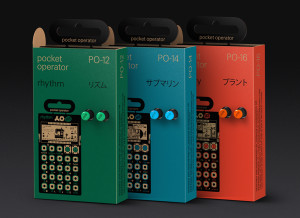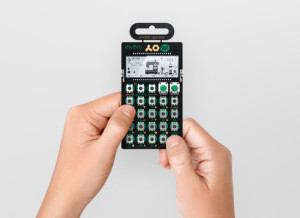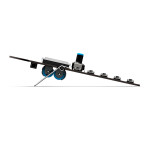GEAR REVIEW: All 3 Pocket Operators by Teenage Engineering
I always get dark when people refer to studio kit as “toys”. Especially when you save up the pennies to finally cop some new dopeshit microphone or some flavor of compression you didn’t previously have covered, and some well-intentioned friend offers congratulations for your new “toy”.
You’re standing at the precipice of elation, gazing into vast, uncharted territory—which has been made newly available to you by the purchase of this equipment—and in the eyes of your non-musical peers, it’s tantamount to a G.I. Joe.
Maybe there’s something sweet about their comparison, in that it suggests excitement or desire. I’d like to think that I’m filled with a similar childish glee, but that’s about where the similarities end for me.
It’s not like I don’t get it. Most of the uninitiated can’t really relate to major equipment purchases in terms of the potential energy they represent, so they relate through the more familiar ideas of fetishization of the object and the joy of consumerism.
Like the majority of you that might read this, I make my living making music, so most gear purchases are metaphorically closer to the role filled by a tool. A general contractor purchases a new saw because it can cut in a way that none of the others already in his or her arsenal can, and in a similar way, we grow our collections in the studio.
I’ve been thinking about this a lot the last couple of days after picking up the suite of Pocket Operators, because I don’t think I’ve ever seen a device at any price that so deftly straddles the line between tool and toy.
It’s so beautifully made and packaged that it’s clearly intended as an object of desire. We’re supposed to want it like we once wanted new toys. And yet, the feature set is as deep, or deeper, than that found in many modular pattern sequencers.
And it has built in sounds, patch memory and crazy graphics? There are solder connection points available to you to connect external speakers and programmers? What the hell are these things?
The Collection
Okay, so onto the technical basics. The masters at Teenage Engineering, in collaboration with the fashion label Cheap Monday, have developed a new suite of incredibly cool and unbelievably inexpensive synthesizers ($59!!) called Pocket Operators. PO-12 Rhythm, PO-14 Sub, and PO-16 Factory.
“Rhythm“ is a grimy, minimal electronic drum machine that sits somewhere between a Linn 9000 and TR-808, but ruggedly Lo-fi. “Sub” is a 2-octave-plus-a-minor-third bass synth with a wide range of useable sounds and includes FM, phase distortion, wavetable, and physical modeling. “Factory” is also a synth that provides 2 octave plus a minor third in range, but this one comes loaded with lead sounds drawn from a similar range of palettes, and sits a few octaves above the Sub.
Both Sub and Factory have what Teenage Engineering describe as a “micro drum machine”, which essentially means that you get a sort of light version of the Rhythm unit inside Sub and Factory, in addition to their synth sounds. Like the full Rhythm unit, the micro drum machine has 16 drum sounds though you can only program one drum per step (no kick and hi hat on the same beat) and the multifunction knobs behave a little bit differently. More on that in a moment.
At their core, each PO is a 16-step pattern sequencer, capable of holding 16 patterns, with 16 sounds to perform those patterns. (Actually, 31 for Factory and Sub if you include the micro drum machine). These patterns can be entered via step sequencing or with real-time punch input.
There are 16 effects built in to all three. The effects cover a very wide and useful sonic palette. From bit crushing and distortion, to pass filter sweeps and drops to beat repeats, these effects are hugely transformative and can make a simple sequence sound like something you labored over for hours, with just a few deft taps on the keys.
Using the Multifunction Knobs
Each of the three units has two multifunction knobs as well. Depending on the combination of buttons you employ, these knobs can manipulate a vast number of settings. For example, while holding the “bpm” button, knob “A” controls the swing amount and knob “B” controls the master BPM. Switch over to the program section, and each knob controls something program-dependent, with different options for each Pocket Operator.
On Rhythm, knob A can be used to pitch individual drums and knob B can control decay time. On Factory and Sub, the knobs can be used to manipulate global aspects of the synth patch like filter cutoff, FM rate / amount, LFO amount, so many fun and useful options. Additionally, you can use the knobs to step edit a specific step’s pitch in the synth section or to select a drum sound in a sequence.
The behavior of the multifunction knobs for the micro drum machine are slightly different. Knob A controls pitch across the whole drum set, while knob B controls overall volume for the drum machine. So, similar to the Rhythm Pocket Operator, though slightly limited, in keeping with the micro vibe.
Sub and Factory also have 16 “play” styles. The play styles are essentially articulations: Glisses, doubletime arpeggiator runs, triplets, held notes, chords, even transpositions. These key styles also apply to the patterns in the micro drum machine section, so that can lead to a whole host of other fun and useful rhythmic variation.
Audio out on each is handled by a 3.5 mm TRS jack. However, Teenage Engineering has even been clever in this bit of design: Each Pocket Operator has two TRS jacks, one the top right and one top left. Use a simple TS cable out of the top right jack and you’re getting audio out of the Operator into your system. But the Operators are all smart enough to send and receive clock as well. If you own two or more Operators, using a TRS cable instead will send audio down the tip connection and click down the ring connection. The manual describes setting up the sync modes required to link them, and it’s really, really easy to set up.

The Pocket Operators easily sync up by changing one into the other. With minimal setup, they can also integrate seamlessly with full-fledged modular gear.
If you own any modular synth gear, you could distribute clock from your modular system to any or all three Operators to put them in lock step with a wall of synth madness. For more in-the-box users, a simple audio click out of the computer could be used to force them to lock to the DAW. Awesome.
A few important caveats for our modular people, however: The manual says it allows a max of 6 volts peak-to-peak for clock input, so you may need to attenuate the clock signal’s voltage going from your modular synth to the PO. (This should be fine for any modular gear that puts out 0-5V logic signal, but if you’re using anything that operates on 10V peak-to-peak rail, you’ll want to attenuate that signal, lest you risk damaging the unit).
If the previous sentence reads like Ottoman Turkish to you, don’t worry, each Operator in the family is a universe of fun by itself and they get exponentially more bonkers when you hook up all 3.
In Use
Okay, all that is well and good, but holding one of these in your hands and hitting go is where it’s at. These things are so f*ing fun to use.
Patterns can be entered by step or in real time and every single parameter on these things is automatable and can be adjusted in real time. Perform a rising lo pass filter sweep into a crunk 32nd-note run and then a big triplet kick drop with distortion all in real time. (That fun little bit of sequencing takes 4 key presses on a Pocket Operator, by the way.)
Gameboy-sounding, Detroit-ass 303 runs with filter cutoff and LFO syncing modulation, crazy sub bass sounds that morph and evolve, all with simple knob twists and gestural multi keypresses. SO fun. Not digging it? Hold down the “key style” or “effect” button as appropriate, and you can erase it all in real time, too.
The pattern sequencer is powerful but simple in operation. Patterns can be switched, copied, and made to play in order, again, all in real time.

Got a great loop working in pattern 1? Copy it to pattern 2, 3, and 4, edit drops for each, and set them all to run in order, all with the beat going the whole time. In fact, you can set up to 16 patterns into a pattern sequence and have multiple instances of the same pattern in an order. (I.e., 1, 2, 1, 3 or 1, 1, 1, 2 and so on.) It’s rare to find a device so user-friendly and so open-ended.
The best thing about the Operators, again, is just how damn fun they are to use. Even though the feature set is this rich, it’s all integrated so smoothly that you don’t think about it once you’ve logged a few hours using them.
Learning all the gestures feels like learning cheat codes for Nintendo, and the LCD graphics evoke old school Tiger handheld games. It looks like a toy, plays like a toy, but functions like a useful tool.
So, buy them all. So so fun.
Room for Improvement
In the interest of full disclosure (and of not being a total fanboy), I have found a few things that are slightly less than awesome.
It’s pretty clear from the pictures how spartan the design is. It really is just batteries sitting on a board with a few chips, protected by an LCD and a bunch of calculator buttons. It’s so elegant and so attractive and so cheaply made (hence the price tag) that if you intend to log lots of time on it, It’s definitely worth ponying up for the case. That’s another $39, so it’s actually closer to $100 once you accessorize. Small gripe. The cases are also all on backorder still because of a manufacturing defect so those are a couple of months out. Also a small gripe.
The biggest bummer by far is that the Sub and Factory units don’t have a chromatic sequencer, meaning that you only get two octaves and a ninth of the C major scale, up to C to D two octaves above.. I was actually quite shocked by this. I dug through the startup guide, then the detailed manual, then the geeks-yelling portion of the internet and found many geeks yelling about this deep limitation. “Nerfed” was the word.
Still not having the answer, I went to digging through the full manual again, and I found this to be strangely limited in a few ways as well.
The manual doesn’t actually ever fully detail the patches or play styles, so you just have to play with it and sort of figure out what’s what.
This is awesome in a way, because you’re playing with it and that’s super fun, but it seemed like such a strange disinclusion. The manual clearly lists the effects for all three Pocket Operators and the sounds for Rhythm, so it certainly must have been a conscious omission, but a strange one nonetheless.
I wonder if the decision to limit the main operation to C major only was also conscious choice by TE to make these devices more accessible to the casual user. With this diatonic quantization, literally every note on both devices can work at all times. In standalone operation, this is very gratifying, but will require a bit of messing around to get the Pocket Operators to play in the context of a larger production that is in a key other than “C” or its modes.
So, an hour into playing with Sub, still stuck in C major and I’m still digging around online. I Googled up a gent who had written a few short and inexpensive eBooks that are basically the fully-detailed user guides that Teenage Engineering should have written. So, big ups to Peter Andersson, because he had the answer to the white keys quandary: Effect #15 on both Factory and Sub is a half step transposition, upwards (which is how you get the minor third).
In all the Teenage guides, they list effect 15 as ”parameter LFO” which is a little misleading. Since you can’t record two effects on the same step, you can’t distort an Eb or bit crush an F#, though a couple of the play styles do seem to transpose properly. Theoretically, a user could make use of the two options to accomplish whatever needs to happen harmonically, and still have access to an effect or play style on any given transposed step.
Without knowing anything about the programming architecture, it’s impossible to do anything but whine about this, but it does seem like it would have been possible to implement a chromatic scale into the step sequencing side of the program. This would have made the synth POs much more usable for professionals. That being said, you can still totally play in every key, you just have to sequence the FX in order to do so.
Here’s a dumb little Pocket Operator version of “Dance Yrself Clean” by LCD Soundsystem. (I chose this tune because it’s in Db..so you really can make it play in all 12 keys, you just have to work a little.)
It is worth mentioning again at this point that these complaints are being levied at a $59 synthesizer that packs an incredible level of functionality into a device this tiny. In the context of musical equipment, $59 doesn’t even get you most guitar pedals, nevermind a standalone device that’s well-enough equipped to make full compositions on.
It so refreshing to see such a thoughtful take on devices we’ve seen a million times before, which is so well designed that the user feels the joy of a child with a new toy. The Pocket Operator series is a collection of incredibly unique products with such an interesting perspective that it’s hard to imagine that everyone won’t want one. I believe they’ve already sold out of one production run (Rhythm was back-ordered when I copped mine) and this run is soon to follow, I’m sure.
I’m in love with these things.
Brian Bender is a producer/engineer and owner of The Motherbrain in LA. He has recently produced albums with Gabriel Gordon, Jose James, Takuya Kuroda, and Bing and Ruth.
Please note: When you buy products through links on this page, we may earn an affiliate commission.











Lauren Meleney
August 3, 2015 at 1:29 am (10 years ago)cool review! I’m about to buy one for my boyfriend, but can only afford one: which one should I get, Rhythm or Sub??
Justin C.
September 15, 2015 at 12:06 pm (10 years ago)Tough to say Lauren, they’re both so cool! I’d say if he’s more of a musician or instrumentalist, go for the Sub and if he’s more of a producer/beatmaker go for the Rhythm. It all comes down to personal taste. And I bet if he likes one, he might just buy the other for himself!
Ashley Kippels
December 2, 2015 at 4:02 pm (9 years ago)My hubby wants an analog synthesizer but I really want to get him one of these for Christmas! Any ideas which would one be best? He has turntables, pioneer mixer, and a Roland drum machine already.